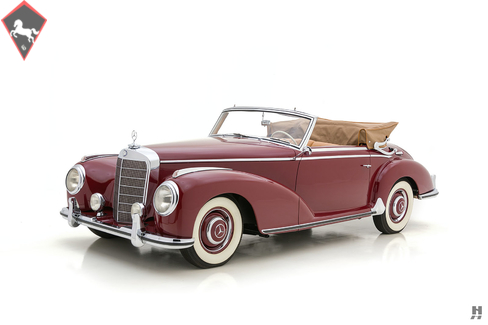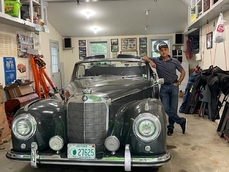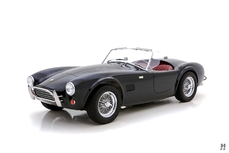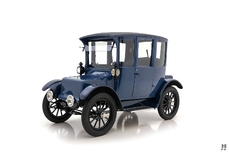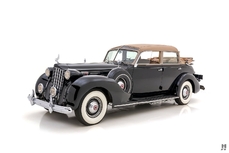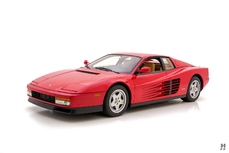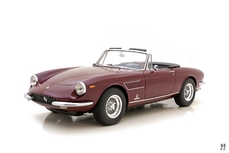Mercedes-Benz 300S / Sc Cabriolet W188 Cabriolet 1953
General description :
The flagship 300-series sedan debuted at the Frankfurt Auto Show in 1951. The large, elegant six-cylinder sedan was graceful yet imposing, a statement of European luxury that was available in either four-door sedan or striking four-door full convertible configurations. The 300 received great praise for its exceptional engineering and build quality and was a favorite of celebrities and heads of state alike, including Chancellor Konrad Adenauer, whose affinity for the sedan earned its eponymous nickname. Shortly after the big sedan and convertible debuted, Mercedes unveiled a sporting version, the 300S – the “S” denoting it as Super. This new variant bridged the gap between the four-door 300 and the much anticipated 300SL sports car. The 300S chassis was shortened by 25 centimeters and was available as an elegant closed coupe, a beautiful open-topped cabriolet, or a disappearing-top roadster. S specification cars featured an uprated 3.0-liter inline-six. A trio of Solex carburetors and a boosted compression ratio helped the big six produce a healthy 150 horsepower, up from the standard car’s 115. The engine is backed by a smooth and reliable four-speed manual with a delightfully slick column shift. The suspension is independent in front with a swing axle arrangement in the rear, sprung with coils. While tuned for comfort, the 300S is still a respectable handler for a car of its size while also remaining impressively poised at speed.
As Mercedes-Benz’s top offering, the cabin was, of course, luxuriously trimmed in leather, wood, and wool. Jewel-like chrome trim and switchgear grace the elegant dashboard and make the 300S feel like an extraordinary place to be. All 300s featured powerful vacuum brakes as standard, along with other luxuries such as windscreen washers and reclining seats. Exclusivity was assured as only 560 examples of the 300S were hand-built between 1952 and 1958. That exclusivity also came with a price: A whopping $12,680 in 1953. Notable 300S owners included Cary Grant, Gary Cooper, and The Aga Khan, who all could easily afford the cost of entry into the exclusive club.
This exceptional 300S dates from 1953 and is one of only 203 Cabriolet As constructed. It is a numbers-matching example confirmed by Daimler-Benz build records and is very well-documented, with just three owners from new. The first owner cherished it for 26 years, from 1953 through 1979. It was then passed on to the second owner, who clearly also had a great love for it and cared for it exceptionally well. They subsequently treated it to a no-expense-spared restoration by respected marque expert Don Mertz, completed in 2010. Restoration specialists generally agree that the 300S is one of the costliest of all post-war cars to restore due to its complexity and extensive chrome detailing. The previous owner indeed spent a vast sum to fulfill his dream, and the results are, without a doubt, magnificent. The medium red color is superbly suited to the graceful and curvaceous body lines, lending a subtle sporting character. The fit and finish are truly outstanding, and every piece of the brightwork is finished to perfection. Color-matched wheels and center caps round out the superb presentation.
In true flagship fashion, the 300S was built to order and trimmed with only the finest materials at Mercedes-Benz’s Sindelfingen works. The restoration has faithfully reproduced the handcrafted feel. Leather covers nearly every soft surface in the cabin, with luxurious wool carpeting covering the floors. The dash, windscreen surround, and door caps are covered in exquisitely finished burl wood trim. Switchgear, instrumentation, and the original in-dash radio have also been restored to the highest standards and display a feeling of unparalleled quality. A proper German canvas cabriolet top has been hand-fitted, featuring the signature landau irons and a full headlining. Certificate of authenticity, extensive documentation of its ownership and restoration, a full complement of gorgeous fitted luggage, original handbooks, original tool roll, dual spare wheels, and original jack will all be included in the sale.
Under the hood, the numbers-matching, triple carb engine is meticulously detailed with correct markings, decals, and finishes throughout the engine bay. Performance is on par with the looks, making this a magnificent driving machine. The level of excellence continues underneath the car with correct details, finishes, and hardware used throughout the chassis. It has been well-sorted and, in true Mercedes-Benz fashion, will return plenty of miles of worry-free motoring.
Since the restoration was completed in 2010, this fine machine has been honored with several first-place awards from many prestigious concours events. It remains exceptional and would be a welcome entry into nearly any prestigious concours or driving event in North America or Europe.
Offers welcome and trades considered
1953 Mercedes-Benz 300S / Sc Cabriolet W188 Cabriolet is listed for sale on ClassicDigest in St. Louis by Hyman Ltd. for $649500.
Car Facts
Car type : Car Make : Mercedes-Benz Model : 300S / Sc Cabriolet W188 Model Version : Cabriolet Engine size : 0.0 Model Year : 1953 Sub type : Convertible Location : Missouri Vehicle Registration : Undefined
649500 $
People who viewed this Mercedes-Benz 300S / Sc Cabriolet W188 also viewed similar Mercedes-Benz listed at ClassicDigest
Other cars listed for sale by this dealer
About Mercedes-Benz
In the annals of automotive history, the journey of Mercedes-Benz is a tale that unfolds with the ingenuity of its founding pioneers. In the year 1886, Karl Benz crafted the Benz Patent Motorwagen, a creation that would go down in history as the world's inaugural automobile. Unbeknownst to him, this moment marked the genesis of what would evolve into the most illustrious premium car manufacturer globally. The financial underpinning of this pioneering venture, interestingly, was provided by Karl Benz's wife, Bertha Benz, demonstrating a remarkable partnership that would set the tone for Mercedes-Benz's legacy.A parallel narrative emerged not far away, as Daimler-Motoren-Gesellschaft, founded by Gottlieb Daimler and Wilhelm Maybach, entered the scene. In 1901, they unveiled their automobile under the now-famous moniker "Mercedes," meaning "godsend" in Spanish. This name was bestowed upon the car at the behest of Emil Jellinek's daughter, the distributor for Daimler-Motoren-Gesellschaft. The wheels of innovation were set in motion.
Fast forward to 1926, a pivotal year that witnessed the merger of Daimler with Benz & Cie., culminating in the birth of Daimler-Benz. The amalgamation saw the adoption of "Mercedes-Benz" as the distinguished trademark for their automobiles, fusing the legacies of two visionary entities into one.
Contrary to perceptions of conservatism, the trajectory of Daimler-Benz unfolds as a chronicle of industry firsts. From the introduction of the honeycomb radiator to the float carburetor, and the pioneering implementation of four-wheel brakes in 1924, Daimler-Benz consistently pushed the boundaries of automotive innovation. The diesel-powered Mercedes-Benz 260 D in 1936 marked the inception of diesel engines in passenger cars. The iconic Mercedes-Benz 300SL Gullwing made history as the first car with direct fuel injection, albeit the Gutbrod's tiny 2-stroke engine can claim precedence.
Safety innovations became a hallmark, with Béla Barényi's patented safety cell design in the "Ponton"-models in 1951, featuring front and rear crumple zones. The W116 450SEL 6.9 saw the introduction of the Anti-Lock Brake system (ABS), another pioneering safety feature. From the first production airbags and beyond, the legacy of "firsts" continued to be etched into the fabric of Daimler-Benz.
Over its centennial journey, Mercedes-Benz has not merely produced cars but has sculpted automotive icons. The SSKL, 710 SSK Trossi Roadster, 770K Grosser, 540K Spezial Roadster, 300SL Gullwing, w100 600 Pullman, w111 280SE 3.5 Flachkühler, w113 230SL Pagoda, w109 300 SEL 6.3, and w201 2.3-16 Cosworth stand testament to the brand's commitment to engineering excellence.
The roaring Silver Arrows, or "Silberpfeile," including the W 25, W 125, W154, W165, and W196, created a legacy of dominance on the racetrack. These machines were not merely cars; they were expressions of precision, speed, and an indomitable spirit that left their competitors in the dust.
As Mercedes-Benz marches into the future, it does so not just as an automaker but as a custodian of a legacy, a torchbearer of innovation, and a beacon of automotive excellence. The road ahead is sure to witness the continued fusion of cutting-edge technology, timeless design, and an unwavering commitment to setting new standards in the world of automobiles.
One luminary figure who left an indelible mark was Béla Barényi, often heralded as the "father of passive safety" for his pioneering work in safety engineering. His patented safety cell design, featuring front and rear crumple zones, became a hallmark of Mercedes-Benz's commitment to occupant safety, setting new standards that reverberated throughout the automotive world.
Moving through the chronicles, the collaborative genius of Wilhelm Maybach, alongside Gottlieb Daimler, laid the foundation for Daimler-Motoren-Gesellschaft. Their innovations not only birthed the first Mercedes but established a culture of relentless pursuit of technological excellence that remains integral to Mercedes-Benz's DNA.
In the post-merger era of 1926, Ferdinand Porsche emerged as a prominent figure within Mercedes-Benz. His work on the Mercedes-Benz S-Type, a supercharged race car, garnered acclaim and set the stage for a legacy that extended far beyond the marque. Porsche's impact would later extend to his eponymous company, but his influence at Mercedes-Benz during those formative years was pivotal.
As the 20th century progressed, the legendary Rudolf Uhlenhaut emerged as a key figure. Uhlenhaut, an accomplished engineer and the driving force behind the iconic Silver Arrows, played a crucial role in Mercedes-Benz's dominance in motorsports. His engineering prowess and attention to detail were instrumental in creating some of the most formidable racing cars of the era.
In the latter half of the century, figures like Bruno Sacco, the head of design at Mercedes-Benz from 1975 to 1999, left an indelible imprint on the brand's aesthetic identity. Sacco's design philosophy, characterized by clean lines and timeless elegance, shaped iconic models like the W126 S-Class and the W201 190E, solidifying Mercedes-Benz's reputation for luxury and sophistication.
The narrative would be incomplete without acknowledging the contributions of engineers like Hans Scherenberg, whose leadership in the 1970s ushered in a new era of technological innovation at Mercedes-Benz. Scherenberg's tenure saw the development of groundbreaking technologies, including the Anti-Lock Brake system (ABS) and the introduction of airbags in production cars.
